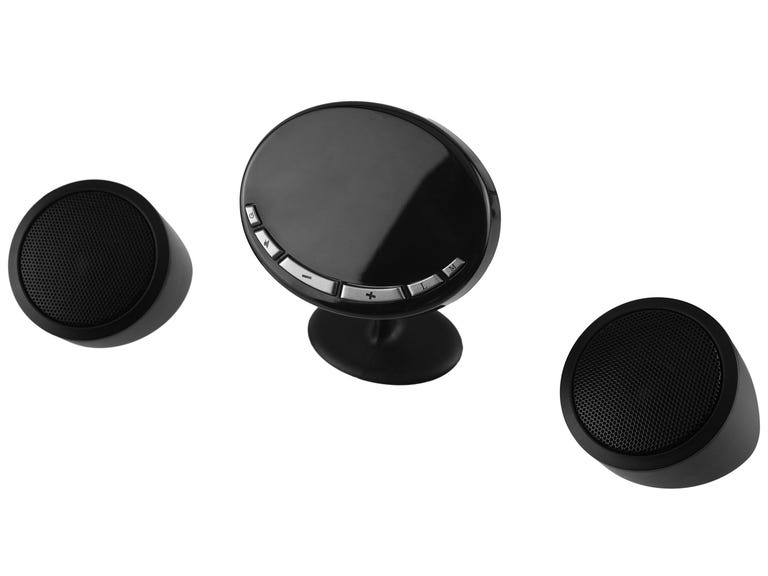Some high-tech cars include lane departure warning systems as options, and precollision systems have become almost common, but the Mobileye AWS-4000 makes it possible to retrofit a car with this technology. Mobileye's lineup of collision warning cameras covers a range for consumer to fleet applications, with the AWS-4000 designed for large trucks. The AWS-4000 is an installed unit that uses a camera mounted in front of the vehicle to intelligently process information about lane lines and objects, sending the data to a display on the dashboard to warn the driver of potential hazards.
The Good
The Bad
The Bottom Line
Design
Although well-styled, the AWS-4000 display pod and its associated speakers are bulky, although could be mounted out of site in a track cab. The display pod is mounted on a stalk, which lets it swivel, so it can be aimed at the driver. Given its size, it should be mounted either in the center or very left-hand side of the dashboard, so not to interfere with the driver's forward view, but still have its information accessible at a glance.
The display pod is oval, and its icons are hidden by dark translucent plastic when not lit up. Buttons follow the curve on the lower edge of the display pod, letting you control volume, power, and do some configuration of the system.
The actual icons the system uses are very easy to understand, with a blocky car on the display indicating when you are close to a car in the lane ahead. Lane line graphics are also very obvious in what they mean.
The system's speakers are unnecessarily large, as they merely blast warning tones into the cabin. Each one is about half the size of the display pod and intended to be mounted on either side of the cabin. They could potentially be mounted in the footwells, keeping them out of sight, but they will be particularly noticeable if mounted on the dash or A pillars.
Features
The AWS-4000 does two things: warns you of impending collisions and if you are drifting out of your lane. The first, called Headway Monitoring by the manufacturer, lights up the car icon in the display if you are within a certain distance to the car in the lane ahead. The display shows a number of seconds equal to the amount of time it would take to hit the car ahead if it stopped. As you get closer, the car icon changes from green, to amber, then to red, at which point a warning tone will sound from the speakers.

For lane departure warning, the system will light up a lane line on the display if you are drifting over the lane line in the road. The lane line icon will light up on the side of the display corresponding to the line you are drifting over. Activating the turn signal for the lane line you are crossing defeats the warning. Along with the lane line icon, the speakers emit a rumble strip sound, which serves as an audible warning.
Performance
In our testing, the Headway Monitoring feature did an excellent job of recognizing cars ahead of us, while not getting confused by oncoming traffic, cars in other lanes, or turns. We found the time display particularly useful. As we moved onto higher speed roads, the distance between our car and the one ahead changed, but the number of seconds remained the same. At slower speeds, the distance decreases.
In moderate to heavy traffic on the freeway, we usually had the green icon lit, which still left a generous amount of space between cars, an invitation for other cars to cut in. During city driving, we often had the car icon lit amber or even red, as it is unrealistic in heavy traffic at moderate speeds to leave a big gap in front.
We were impressed that the AWS-4000 could tell when we were slowing and getting ready to stop behind another car at a traffic light, and didn't sound off its warning. Likewise, a couple of times cars pulled out from the curb abruptly into our path, and we appreciated the warning sound from the unit. We did notice that the system won't recognize motorcycles, and anything smaller, of course.
However, our main complaint is that the collision warning is too loud. There is a volume control, but even at its lowest level it is ear-splitting. That loud warning is especially annoying when you are aware of the car in front and already getting ready to hit the brakes.
Lane Departure Warning was less effective, although this was due somewhat to poorly painted lane lines. With a boldly or freshly painted lane line, either solid or dashed, the AWS-4000 lit up its lane line icon and made its rumble strip sound from the left or right speaker, depending on which side the lane line was on. But it didn't register faded lane markings.
Strangely, the rumble strip audio warning is too quiet, even at maximum level. People are likely to drift when they are falling asleep, so the warning should be audible enough to wake a person up. It was impressive that the system knew which turn signal was on, and would still sound off if you had the right signal on but crossed the left lane marking.
In sum
Because it is an installed product, Mobileye doesn't list a retail price. You have to go to a professional installer to get the system. But we understand it is not cheap. The AWS-4000 offers good potential for fleet applications if its installation costs are offset by insurance reductions. Automakers could partner with Mobileye as an OEM (original equipment manufacturer) and install its technology at the factory, possibly using an instrument panel display instead of the pod tacked to the dashboard.



